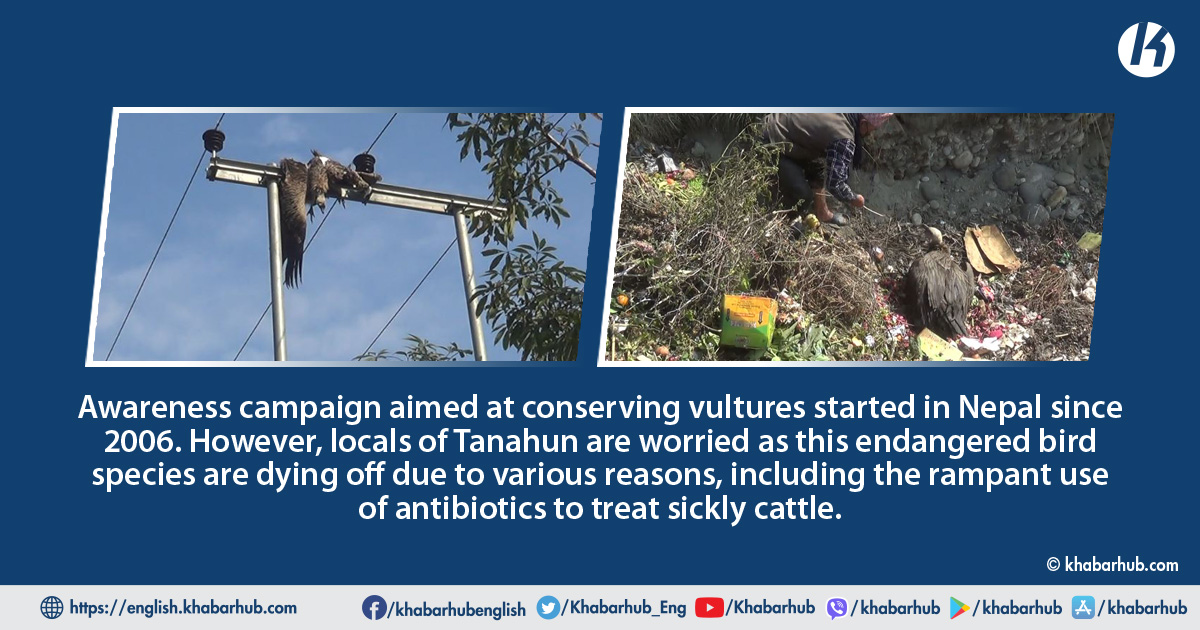TANAHUN: Nepal boasts of conserving vultures. The country’s role and contribution in protecting the vultures are exemplary for the world community.
Besides holding a special significance in the Hindu religion, these birds also have cultural as well as environmental importance.
An awareness campaign has been launched in Nepal since 2006 with the aim of conserving the vulture and highlighting its multifaceted nature.
However, Tanahun locals are worried as vultures are dying every day during the campaign.
A cow protection shelter has been operated in Tanahu’s Byas Municipality-10 for the past three years.
With the construction of cowsheds to manage loose livestock, the number of vultures in the area had gradually increased.
After the death of old cows kept in the shelter, a large number of vultures started gathering for carcasses.
However, the Bholetar-Damauli 33 kV transmission line of Midim Hydropower near the shelter has turned out to be a ‘trap’ for the vultures, according to Narishwar Sapkota, a local of Byas-10, Dumsi.
According to Man Bahadur Dar of Tanahu Byas-10, more than 100 vultures have died due to electrocution after the expansion of the transmission line of Midim Hydropower.
According to another local Ram Prasad Sapkota, the vultures were killed when they tried to rest on the electricity poles and wires while flying after eating the carcasses as there were no big trees around the cow shelter.
Three vultures died last Monday when they sat on a wire.

The vultures have been playing an important role in making the environment free from pollution, odors and diseases.
These birds have also been identified as natural predator as it helps to keep the environment clean and green.
In the absence of vultures, human health is at risk due to diarrhea, rabies, plague, cholera, measles and other diseases.
According to experts, these birds also help in controlling the spread of various diseases such as anthrax, brucellosis and tuberculosis in cattle due to the carcasses.
According to local Prajapati Sapkota, the campaign has supported them to make the new generation understand, and study and observe vultures.
Tulsiram Sapkota, Ward Chairman of Byas Municipality-10, says that the cow conservation shelter along the Madin River is at risk of river erosion after the vultures started to die.
The ward office has set a goal of long-term implementation by making a plan to build a restaurant and safe resting place for vultures along with the shelter.
Likewise, Division Chairman Tulsiram Sapkota said that a request has been made to the Division Forest Office, Tanahu not to allow the felling of “simal” trees in the community forest near the conservation shelter.
Although the number of vultures has increased due to the conservation of vultures, they have been dying prematurely due to electrocution due to unmanaged power transmission lines.
Although the ward office and locals have been urging the Midim Hydropower and Nepal Electricity Authority to make the power transmission line safe, no action has been taken so far.
A study has shown that a vulture can support US$11,000 in terms of finance against carcass management.
Like other bird species, the vulture’s males and females are not easily separated.
Pairs of vultures live together for life, from nesting to hatching and rearing.

In Nepal, vulture habitat is found in the Terai and Mid-Hills forests of western Nepal. The vulture is a bird that prefers to live in tall, large “Simal” trees.
Environmentalists say that it protects the environment from epidemics of infectious diseases including diarrhea, cholera, measles, rabies, tuberculosis, and plague.
Despite the fact that there were about 1.6 million vultures in Nepal in the 1990s, the conservation campaign was started after the declining number of vultures continued to go unabated.
In 2004, a summit on vulture conservation was held in Kathmandu in which various issues were raised to increase the number of endangered vultures.
Nepal, which has 9 species of vultures, has achieved international success in vulture conservation.
Nepal had also launched a systematic vulture conservation campaign in 2006.
Vulture conservation programs are still being implemented in different districts of the country by creating vulture save zones.
Nepal is the leading country in making policy decisions on vulture conservation by banning the use of diclofenac.
In 2008, Nepal adopted a five-year ‘Vulture Conservation Action Plan 2009-2013’ for the conservation of vultures and put forward policy and practical programs.









Comment